A,D,E,G,M,P,V
Meeting in Oslo in 2017 the residency by PRAKSIS called ‘For A Rainy Day: Publishing As A Site Of Collectivization’, developed with artist Iz Oztat, Torpedo Bookshop / Torpedo Press and publishing studio Eller med a we found each other in a group of seven. In the residency- period we explored publishing as an integral part of artistic practice, and its potential to bring groups together to articulate artistic imaginaries, shaping communities and propose alternative value systems and political horizons. We started developing and carrying out our own rituals; exquisite corpse exercises of writing down an action to be performed only seeing the sentence above; reading the texts out loud to transform them into collective sound; choosing from the actions in the text and performing them... This process enabled us to work towards collective articulated artistic forms with everybody’s input and gave voice to how we want to treat each other.We are Vika Adutova, Maria Gordana Belic, Eva Funk, Araiz Mesanza, Daniela Müller, Gabrielle Paré and Per Westerlund.
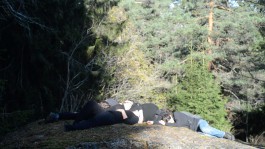
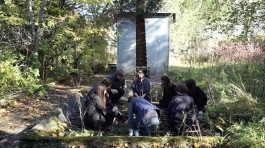
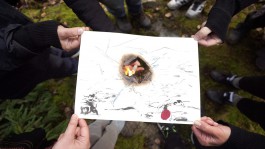
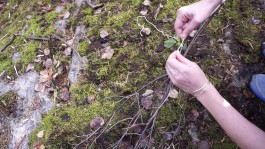
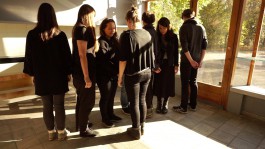
IT IS A GOOD EXCERCISE
Maria Belic, Daniela Müller and Per Westerlund take on the spirit of Barcode Challenge, uniting their fellow residents through a streamed “How to” martial arts session. You are welcome to join the group; strengthen your resolve, discipline your mind and protect what is dear to you.
ca. 45 min performance with a video- live stream PUB, Oslo, 2017
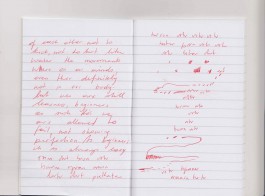
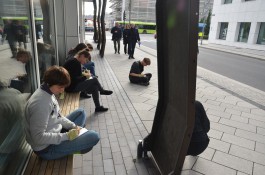

DON’T REST, NARRATE - PUBLICATIONS
Throughout the residency we went through a series of arranged and self-lead activities that focused on aspects of publishing and collaboration. Collective working processes of exploration and action developed over the residency, one result of which is a set of nine volumes produced individually by each participating artist and PRAKSIS with two constraints: an A5 format and a three-week working time. The individual volumes come together as a single collective edition.
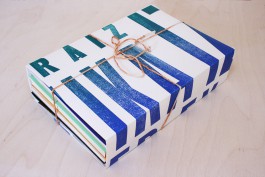
DON’T REST, NARRATE (THE EXQUISITE CORPSE)
Starting from writing excersies Daniela Müller unfolded an internet project made with Vika Adutova, Maria Belic, Eva Funk, Araiz Mesanza, Iz Öztat, Gabrielle Paré, and Per Westerlund based on a written version of the Surrealist drawing game, “The Exquisite Corpse”. A participant would write a line; another would respond to it in writing, fold the paper so the first line was concealed, hand the paper to the next participant, and so on. Müller’s project animates the writing and imagery generated in the course of the game. Words, symbols and motifs flicker across the dark screen, bringing together individual thoughts from the eight artists in poetic and playful combinations. This digital publication is in conversation with its parallel printed form—each function separately, but may be supplemented by the other.
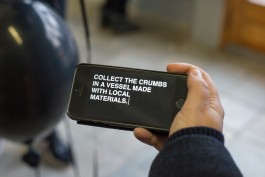
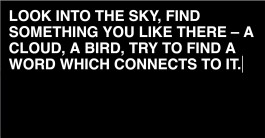
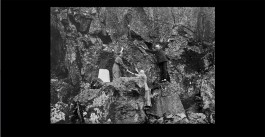
DON’T REST, NARRATE
We got invited by the Guttorm Guttormsgaard’s archive to open an exhibition of work resulting from a collective process of carefully handling Guttorm Guttormsgaards Archive. Guttorm is himself an artist who has produced and collected printed material (among other things) throughout his life. Located in Blaker, in a three-story building that was once a dairy factory, the archive surrounds and consumes Guttorm’s house, study, studio, exhibition spaces as well as a cafeteria used for public gatherings. Carefully approaching the archive we showed artworks and objects from the archive with our publications, a sound piece and various artworks from the group. Don’t rest, narrate, the title of our presence in the archive and the attic, insists on the multiple meanings of both verbs. Don’t rest: a refusal to “cease work or movement”, an inability to “be placed or supported so as to stay in a specified position”, an acknowledgement that the responsibility can’t be handed over and needs to be owned. Narrate: laboring to produce written and spoken accounts in language but also going into the roots of the word to embrace experiential ways of knowing and making known.
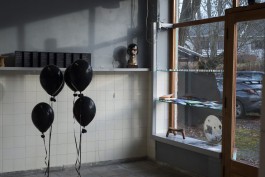
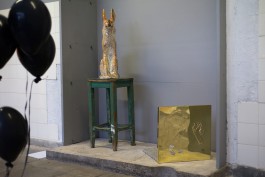
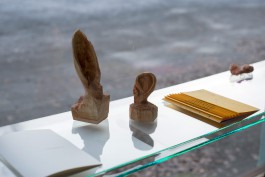
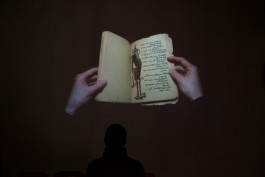
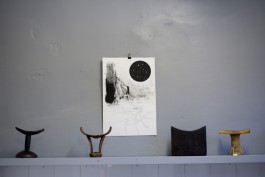
DON’T REST, NARRATE - PERFORMANCE
We joined the objects in the attic with a collective lexicon of attitudes and actions. In the triangle offered by the attic, we are among a circle of friends; living an dead, anonymous and known artists / makers. Works by Guttorm Guttormsgaard, Asger Jorn, Marshall McLuhan, and Zişan got brought up from the cellar. Liv Kolsrud’s triangles woven with linen and horse hair (1995) were moved upstairs from her studio located under the same roof between the cellar and the attic. John Amos Comenius’s book Orbis Sensualium Pictus, Lillebeth Foss’ Cultural Spy and Hannah Ryggen’s tapestry were carried into the attic from Guttorm’s home. In the performative action each of us was approaching the objects in different ways, trying to reflect the rare daylight on the objects, narrating, humming, shifting objects and replacing them with others. Simultaneous journeys in space and time. An enchanted dérive through this part of the archive. The audience could walk in and out of the space as they liked.
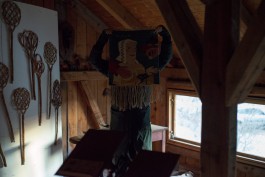
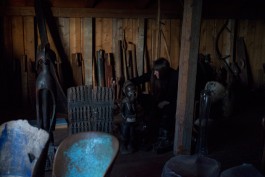

„A Novel“ – Lets read together
To write a novel is seen as a monumental undertaking to accomplish in one’s lifetime. None of us has written a novel before and to take on this task together, forming a temporary writing society means something new to all of us. Believing in realizing a novel in a timeframe of one month introduces already a form of possible failure. Embracing this defeat we will work ’til the end.
To conclude our residency at Apartment Project in Berlin in August 2018 we opened the doors and invited to join readings and activities.
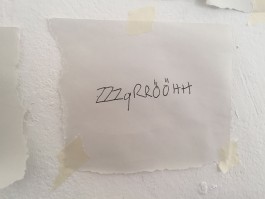
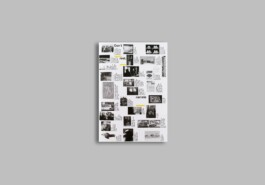
A,D,E,G,M,P,V
Meeting in Oslo in 2017 the residency by PRAKSIS called ‘For A Rainy Day: Publishing As A Site Of Collectivization’, developed with artist Iz Oztat, Torpedo Bookshop / Torpedo Press and publishing studio Eller med a we found each other in a group of seven. In the residency- period we explored publishing as an integral part of artistic practice, and its potential to bring groups together to articulate artistic imaginaries, shaping communities and propose alternative value systems and political horizons. We started developing and carrying out our own rituals; exquisite corpse exercises of writing down an action to be performed only seeing the sentence above; reading the texts out loud to transform them into collective sound; choosing from the actions in the text and performing them... This process enabled us to work towards collective articulated artistic forms with everybody’s input and gave voice to how we want to treat each other.We are Vika Adutova, Maria Gordana Belic, Eva Funk, Araiz Mesanza, Daniela Müller, Gabrielle Paré and Per Westerlund.





IT IS A GOOD EXCERCISE
Maria Belic, Daniela Müller and Per Westerlund take on the spirit of Barcode Challenge, uniting their fellow residents through a streamed “How to” martial arts session. You are welcome to join the group; strengthen your resolve, discipline your mind and protect what is dear to you.
ca. 45 min performance with a video- live stream PUB, Oslo, 2017



DON’T REST, NARRATE - PUBLICATIONS
Throughout the residency we went through a series of arranged and self-lead activities that focused on aspects of publishing and collaboration. Collective working processes of exploration and action developed over the residency, one result of which is a set of nine volumes produced individually by each participating artist and PRAKSIS with two constraints: an A5 format and a three-week working time. The individual volumes come together as a single collective edition.

DON’T REST, NARRATE (THE EXQUISITE CORPSE)
Starting from writing excersies Daniela Müller unfolded an internet project made with Vika Adutova, Maria Belic, Eva Funk, Araiz Mesanza, Iz Öztat, Gabrielle Paré, and Per Westerlund based on a written version of the Surrealist drawing game, “The Exquisite Corpse”. A participant would write a line; another would respond to it in writing, fold the paper so the first line was concealed, hand the paper to the next participant, and so on. Müller’s project animates the writing and imagery generated in the course of the game. Words, symbols and motifs flicker across the dark screen, bringing together individual thoughts from the eight artists in poetic and playful combinations. This digital publication is in conversation with its parallel printed form—each function separately, but may be supplemented by the other.



DON’T REST, NARRATE
We got invited by the Guttorm Guttormsgaard’s archive to open an exhibition of work resulting from a collective process of carefully handling Guttorm Guttormsgaards Archive. Guttorm is himself an artist who has produced and collected printed material (among other things) throughout his life. Located in Blaker, in a three-story building that was once a dairy factory, the archive surrounds and consumes Guttorm’s house, study, studio, exhibition spaces as well as a cafeteria used for public gatherings. Carefully approaching the archive we showed artworks and objects from the archive with our publications, a sound piece and various artworks from the group. Don’t rest, narrate, the title of our presence in the archive and the attic, insists on the multiple meanings of both verbs. Don’t rest: a refusal to “cease work or movement”, an inability to “be placed or supported so as to stay in a specified position”, an acknowledgement that the responsibility can’t be handed over and needs to be owned. Narrate: laboring to produce written and spoken accounts in language but also going into the roots of the word to embrace experiential ways of knowing and making known.





DON’T REST, NARRATE - PERFORMANCE
We joined the objects in the attic with a collective lexicon of attitudes and actions. In the triangle offered by the attic, we are among a circle of friends; living an dead, anonymous and known artists / makers. Works by Guttorm Guttormsgaard, Asger Jorn, Marshall McLuhan, and Zişan got brought up from the cellar. Liv Kolsrud’s triangles woven with linen and horse hair (1995) were moved upstairs from her studio located under the same roof between the cellar and the attic. John Amos Comenius’s book Orbis Sensualium Pictus, Lillebeth Foss’ Cultural Spy and Hannah Ryggen’s tapestry were carried into the attic from Guttorm’s home. In the performative action each of us was approaching the objects in different ways, trying to reflect the rare daylight on the objects, narrating, humming, shifting objects and replacing them with others. Simultaneous journeys in space and time. An enchanted dérive through this part of the archive. The audience could walk in and out of the space as they liked.



„A Novel“ – Lets read together
To write a novel is seen as a monumental undertaking to accomplish in one’s lifetime. None of us has written a novel before and to take on this task together, forming a temporary writing society means something new to all of us. Believing in realizing a novel in a timeframe of one month introduces already a form of possible failure. Embracing this defeat we will work ’til the end.
To conclude our residency at Apartment Project in Berlin in August 2018 we opened the doors and invited to join readings and activities.

